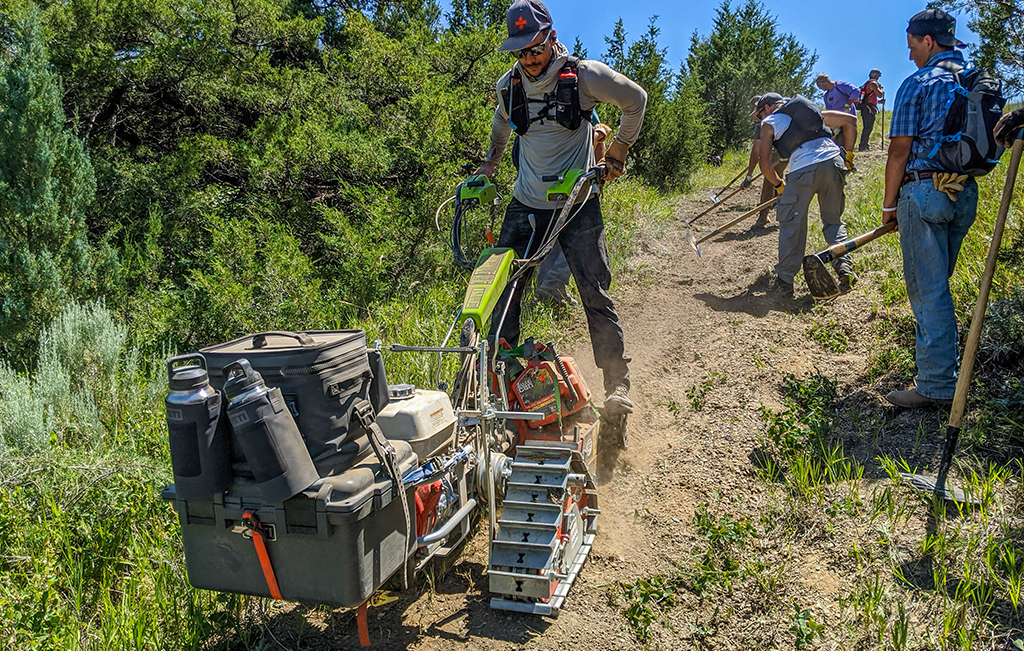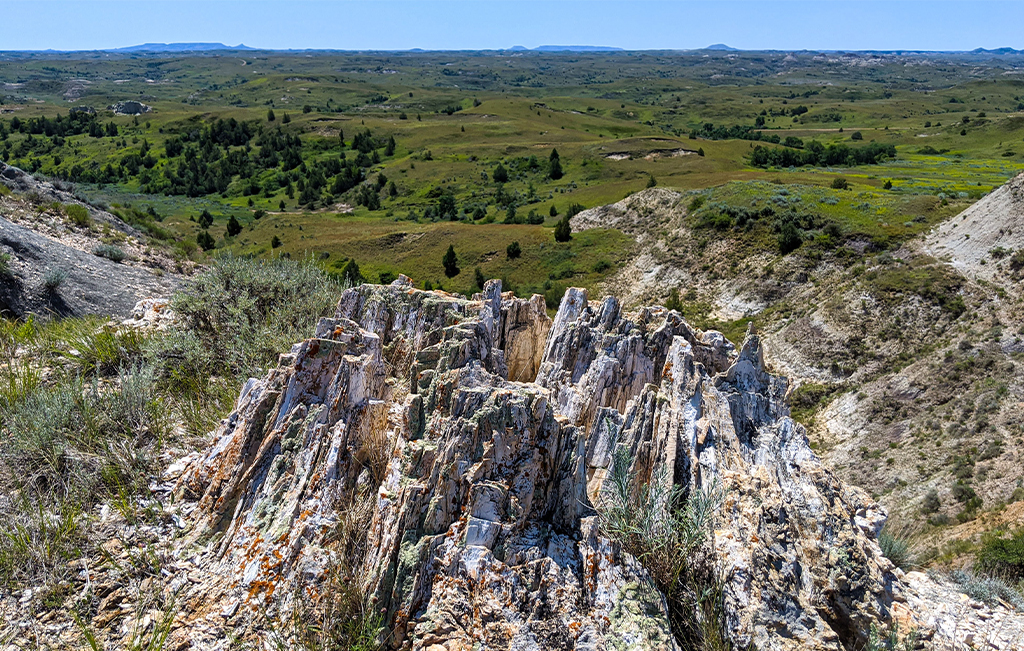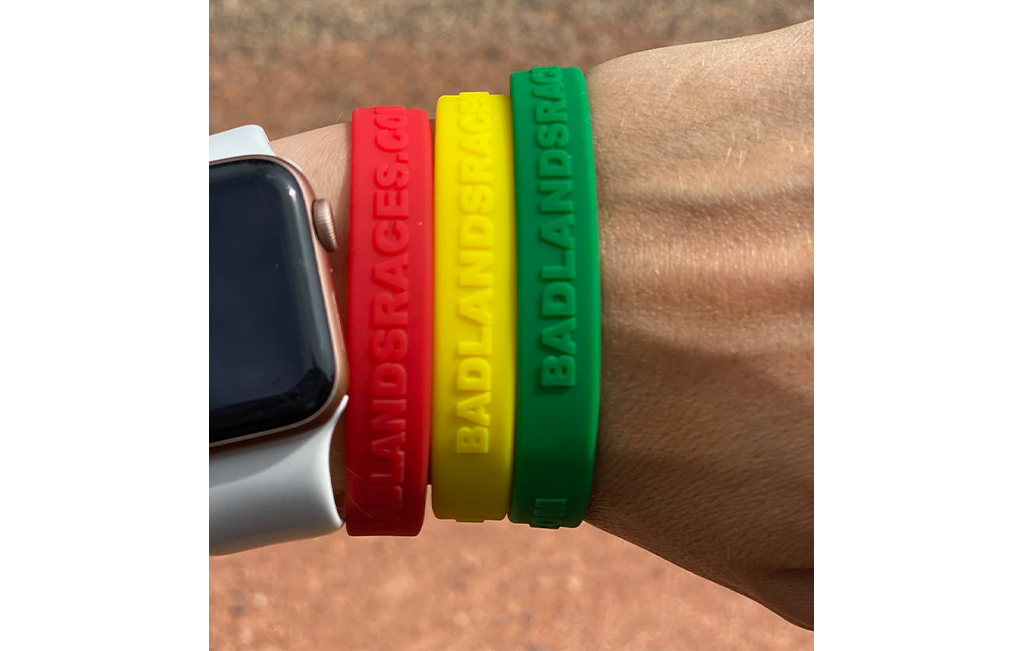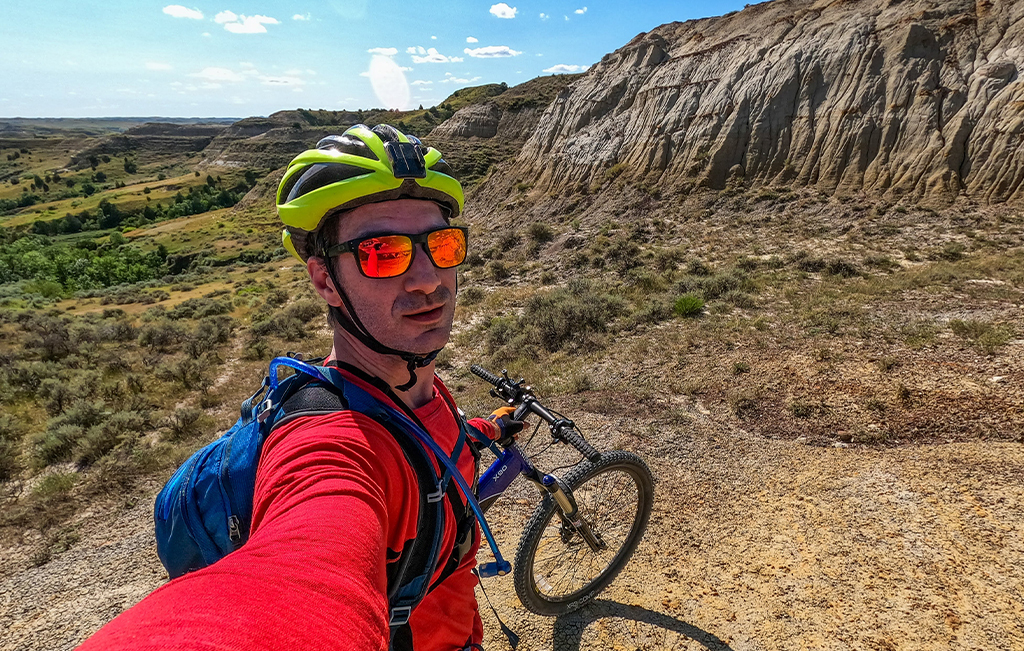Editor’s note: Please consult the CDC or your state health department for information related to the COVID-19 pandemic. When spending time outdoors, please recreate responsibly.
This year hasn’t been kind to race organizers (or anybody else, for that matter). Major foot races like the New York City and Chicago Marathons, and bike races like the USA Cycling National Championships have all been canceled because of the COVID-19 pandemic.
But tucked in western North Dakota, among striated canyons that stretch out like great fingers into a sea of grass, there’s one mountain bike race that’s still on: the Maah Daah Hey 100. More than 100 riders are lining up Aug. 1 for this grueling, 106-mile race, the flagship event of the Badlands Race Series. The eight-year-old competition traces miles of lush grasslands and rugged buttes—the traditional land of the Mandan, Hidatsa, Arikara, Hunkpapa, Métis, Cheyenne and Očeti Šakówiŋ (Sioux) People. It’s a bucket-list ride for any serious mountain biker.
At 151 miles, the Maah Daah Hey trail system is the longest stretch of uninterrupted, non-motorized singletrack in the country. That makes it prime terrain for hiking, backpacking—and mountain biking. Racers who compete in the annual Maah Daah Hey 100 cruise past fossilized trees and clay hoodoos, alongside bison and wild horses, climbing more than 13,000 feet through these remote badlands.

The Maah Daah Hey stretches more than 150 miles through badlands topography; the MDH100 is a 106-mile chunk.
But with COVID-19 still spreading and social distancing guidelines in place in most states, I was surprised to learn that the race series was still on this year. In fact, three other events in the series have already taken place.
“We just wanted to offer people the opportunity to get back to what felt like normal for them, but do it safely,” Nick Ybarra, race co-director and co-founder of the #SaveTheMDH nonprofit, tells me. “People want to get out and start feeling human again. That’s why it was so important for us to have the race, and that’s why we were willing to adapt and make changes for the situation that we’re all in.”
Organizing a race during a pandemic requires adjustments, and Ybarra says they’re taking measures to balance the need for public safety with all the benefits that come from riding and competing. This year, some of the races will have staggered starts so riders don’t crowd together at the starting line. Racers will leave one by one, with distance in between, and they’ll race against personal clocks, more akin to a time trial. Another change: Race officials are asking that riders give each other a 6-foot buffer when possible and allow for passing responsibly.
I wanted to learn more, so I traveled to North Dakota in mid-July to find out how organizers were coming up with creative solutions to maximize safety and keep the race going. Once I arrived, I was immediately put to work.

A push tractor named Wall-E breaks up the dirt.
I met up with Ybarra and his crew at their current basecamp, the Wannagan Campground midway along the trail. I wasn’t the only one who’d made the trek. The group of nearly 40 volunteers was the largest Ybarra had ever had. In years’ past, just a few people would take six to eight weeks to prep the whole path. This year, the team was attempting to do it in one 10-day push. By the time I arrived, they were ahead of schedule: Mowing and trimming was done—it was time for dirt work. Lucky me.
Trail work of this magnitude requires a massive amount of coordination to ensure that no sections are missed and that it’s done right. The goal is to repair the trail in a way that lasts for years. It takes some craft and a surprisingly good understanding of geology and physics.
Badlands, or soft land and rock that have been eroded into steep peaks and canyons, have a high clay content, so when it rains things can quickly turn to boot-sucking mush. Cows and bison tear up the pudding-like track, and once-manageable water channels turn into deep ruts. To build trails that anticipate erosion, Phil Helfrich, Ybarra’s longtime partner in preserving the Maah Daah Hey, tells volunteers to think like a droplet of water: “Imagine where you’re coming from and where gravity wants to pull you.”
In some places, the trail had to be shifted several feet because it has been washed out. I got to work with a hand saw, removing pine branches that were in the way of the rerouted path. Other volunteers used heavy hand tools to level the dirt, fill in ruts and divert the flow of water away from the new trail before the next big storm. Ybarra, meanwhile, wielded the star tool—a walk-behind tractor nicknamed Wall-E. Outfitted with a mechanical dirt-masticating tool called a harrow cultivator (nicknamed Chewbacca, or Chewy, for short), the tractor breaks up packed ground so it’s easier for the rest of us to move it. Even good-intentioned trail work isn’t exempt from the non-motorized vehicles rule that applies to the Maah Daah Hey (e-bikes are prohibited), so while Wall-E is gas-powered, it has to be pushed and pulled manually like the world’s biggest vacuum cleaner.
Once I removed the trees, I switched to dirt-moving duties—exhausting work in mid-July as the mercury climbed toward 90°F. But despite the challenges, it’s easy to see why most of these volunteers return year after year: It’s absolutely stunning country. While raking dirt at one point, I looked up to find myself surrounded by million-year-old petrified tree stumps in a grassy valley, amid badlands the color of Creamsicles.

Petrified wood along the Maah Daah Hey gives way to a valley view.
The Maah Daah Hey, which translates to “something that has been and will be around for a long time” in the language of the local Mandan Nation, is worthy of praise. It passes through all three separate units of Theodore Roosevelt National Park, the vibrant Little Missouri National Grasslands and private land. The trail was built about two decades ago to connect the national park’s North and South Stations, threading through a highlight reel of badlands topography. It was primarily created with equestrians in mind, but mountain bikers quickly fell in love with it.
One of those mountain bikers was a local named Nick Ybarra.
By 2010, the U.S. Forest Service, which maintains the Maah Daah Hey, didn’t have the budget or staff to fix up or maintain the trails. The route was slowly being choked by thick grass, weeds and other vegetation, and disappearing under the forces of erosion.
To raise awareness for his favorite trail, Ybarra, who had never organized a race before, decided to host one. In 2012, he put the word out on mountain biking forums, and 60 riders showed up to attempt the 100-mile course for the first time. Most riders got lost or detoured because the trail had deteriorated so badly that it was hard to follow. But Ybarra says it had the desired affect: Riders discovered this hidden gem, and many later joined efforts to preserve it.

Riders will select a bracelet based on their physical contact preferences.
Ybarra started the #SaveTheMDH organization to improve trail conditions, and in the second year, the Forest Service allowed him to begin fixing the trail with push and string mowers. Over the years, as the race became more famous, the number of volunteers grew. Today, hundreds of volunteers have logged well over 8,000 hours of trail work, with local businesses donating food and tools and even lending vehicles.
But getting the trail in shape for an epic race series that last year drew hundreds competitors is only part of the puzzle when you’re in the middle of a global pandemic.
“With our first race of 2020, we wanted to do it right,” Ybarra says. “We wanted to show that we could have a race event and do it safely. That was the big thing I told our volunteers for the Gravel Battle. I said, ‘We’ve got to do this right, because this thing could go very, very well, or it could go very, very bad.”
In addition to single starts and social distancing rules, race organizers made other changes. Even the aid stations have a new safety protocol. “When a racer comes into an aid station and wants to refill their water bottle, they take their own lid off the water bottle then set it on the table and back up,” Ybarra says. “A volunteer will come and pour the water into the bottle, then back away, and then the racer will come back and take their bottle to minimize contact.”
Ybarra is also implementing something he saw at a friend’s wedding earlier in the pandemic: When a competitor picks up their race packet, they’ll choose a silicone race bracelet based on their physical contact preferences. Green means “I’m comfortable with fist bumps, hugs, high fives. It’s all good.” Yellow is for those who are being more cautious: “Please don’t shake my hand, but I’m fine visiting and talking.” And a red bracelet is for those being the most careful: “Please keep 6 feet back.” Ybarra says that so far people are respecting each other’s boundaries and not taking it personally. Some are starting and finishing the races with masks.

The writer goes for a spin on the south end of the Maah Daah Hey.
With race day looming, I decided I wanted a little taste of the Maah Daah Hey. After trail work one day, I hopped on my bike and headed out for a 10-mile out-and-back ride. It was hot, I was tired from a day of pushing dirt and branches, and I was way out of biking shape. The ride kicked my butt all the same. There were plenty of slippery downhill sections that demanded every bit of focus, and by the end I was hiking my bike up the steeper climbs. According to my watch, it was a poor showing, but my camera roll said otherwise.
“It’s healthy for the trail to have people on it and riding it,” says Lindsey Ybarra, co-founder of #SaveTheMDH and Nick’s wife. “The Maah Daah Hey’s longevity depends not just on the trail work, but also the events and getting people out there. It gives us life, but all of us who ride it and are on it give the Maah Daah Hey life, too.”
All photography by Brent Rose.
